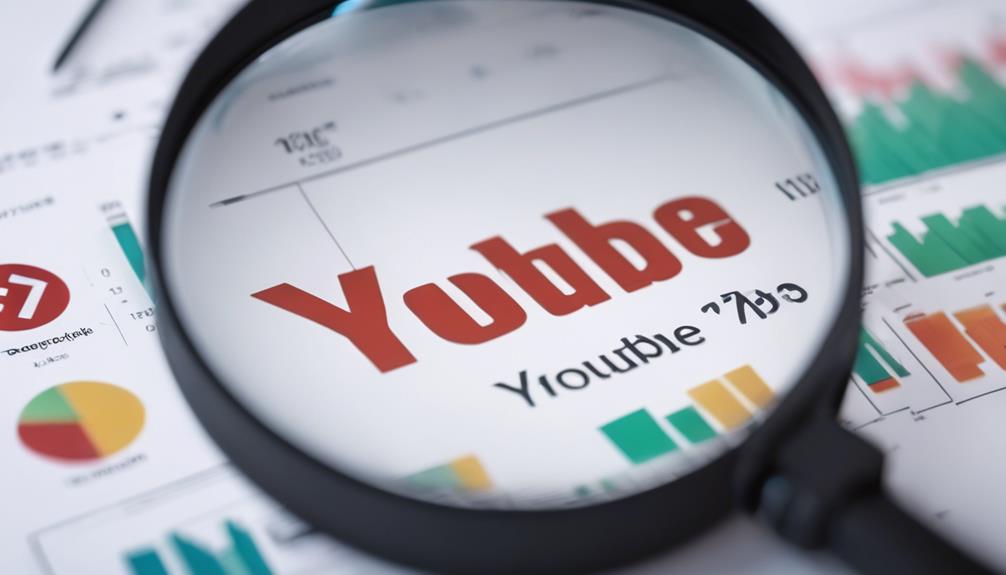
Can YouTubers see who their views are?
While you may fancy yourself invisible, perusing YouTube incognito and leaving no trace, it’s not quite as cloak and dagger as you might think. Youtubers have access to a wealth of data about their viewers, but how much do they really know about you?
Can they pinpoint who exactly is tuning into their latest DIY tutorial or comedy sketch? The answer might surprise you, and it’s certainly worth sticking around to find out.
Key Takeaways
- Youtubers cannot see personal information of viewers, maintaining viewer privacy and anonymity.
- Creators have access to anonymized, aggregated data for insights, but not individual viewing histories.
- Audience demographics, engagement metrics, and viewing patterns are available, but without personally identifiable details.
- Viewer engagement like comments and likes disclose YouTube usernames, but no other personal details are revealed.
Understanding YouTube’s Privacy Policy

To fully grasp whether YouTubers can see who their viewers are, you first need to delve into the intricacies of YouTube’s privacy policy, a key element shaping how data is collected, stored, and utilized on the platform. This isn’t just about understanding permissions and controls, but about the privacy implications and the confidentiality of your data.
When you log into YouTube, your data begins to flow, shaping your viewing experience. However, YouTube’s privacy policy is designed to safeguard your data confidentiality. It’s a robust framework founded on principles of transparency, control, and security. The platform doesn’t share personally identifiable information (PII) with content creators. This is an essential point to note, as it implies YouTubers can’t see who’s watching their videos.
On the other hand, YouTube extensively uses anonymized, aggregated data to provide insights to creators, aiding them in decision making and content optimization. Although this data is comprehensive, it doesn’t compromise viewer privacy. You can rest assured that your viewing habits remain confidential, protected within the confines of YouTube’s privacy policy.
Hence, the boundary between data utility and privacy is well managed, ensuring a balance between content creators’ needs and viewers’ privacy rights.
The Basics of YouTube Analytics
While understanding YouTube’s privacy policy is important, it’s equally crucial to grasp YouTube Analytics, a tool that provides creators with valuable insights without breaching viewer privacy. As a creator, you can leverage this tool to optimize your content and maximize viewer engagement.
With YouTube Analytics, you have access to a wealth of data. Here’s a breakdown:
- Views: This shows how many times your video has been watched. This can give you an idea of the popularity of your content.
- Watch time: This indicates the total amount of time viewers spent watching your videos. It’s a key factor in YouTube’s algorithm.
- Engagement metrics: This includes likes, dislikes, comments, and shares. These metrics provide insights on how well your content resonates with viewers.
- Audience demographics: This shows the age, gender, location, and device of your viewers. It can help you tailor your content to your audience.
Analytics interpretation is key to video optimization. By understanding these metrics, you’ll be able to create more engaging content, reach a wider audience, and ultimately, grow your channel. It’s all about using data to drive your YouTube strategy. So dive into the analytics, experiment with your content, and watch your channel thrive.
Information Youtubers Can See

Although YouTube Analytics offers a treasure trove of data, it’s important to note that there are certain limitations on the viewer information that YouTubers can access. However, the information they can see is still significantly valuable for Content Optimization and gaining Subscriber Insights.
| Key Information | Description | How It Helps |
|---|---|---|
| Views | Total number of times a video is watched | Helps measure overall popularity |
| Watch time | Amount of time viewers spent watching a video | Assists in understanding viewer engagement |
| Subscriber count | Number of channel subscribers | Offers insight into audience loyalty |
| Audience demographics | Age, gender, and location of viewers | Enables content tailoring to a specific audience |
Using this data, you can identify which videos are resonating with your audience and which ones aren’t. You can see where your viewers are coming from, who they are, and what they want. You can then use these insights to fine-tune your content, making it more appealing and engaging.
Information Youtubers Cannot See
Despite the wealth of data provided by YouTube Analytics, there’s certain viewer information that YouTubers can’t access, maintaining a level of viewer privacy. This is due to viewer confidentiality and analytics limitations. Here’s a breakdown of what remains hidden:
- Individual Usernames: While you can see the number of viewers, you can’t see who specifically is watching your videos. Individual usernames remain anonymous.
- Viewer’s Personal Details: YouTube doesn’t provide any personal details like email addresses, phone numbers, or home addresses. This ensures that viewers’ privacy is upheld.
- Exact Location: Though geolocation data is available, it’s generalized to city or country level. You can’t pinpoint a viewer’s exact location.
- Viewer’s Search History: YouTube doesn’t disclose what else your viewers are watching or searching for on the platform.
These limitations serve as a safeguard to maintain a balance between content creator’s desire for insights and viewer’s right to privacy. Despite these restrictions, you can still analyze the available data to understand your audience better and create more engaging content. Remember, it’s not about micromanaging every data point but leveraging what’s accessible to drive growth and engagement.
The Role of Google Analytics

Google Analytics plays a pivotal role in how YouTubers understand their audience. It’s a tool that provides detailed, data-driven insights, allowing you to track viewer behavior on your channel.
From demographics to viewing patterns, you’ll discover a wealth of information that can drive your content creation strategies.
Understanding Google Analytics
Diving into the realm of Google Analytics, you’ll find it’s an invaluable tool for Youtubers, providing detailed, data-driven insights into viewer behavior and engagement. As you navigate this tool, keep in mind Google’s algorithm changes and understand the inherent Analytics limitations.
- Google’s algorithm changes regularly, impacting the way user data is collected and interpreted. Staying current with these changes can help you adapt your strategy for optimal results.
- Analytics limitations can affect the accuracy of data. These include limitations on data collection, processing, and reporting.
- Understanding these limitations and algorithm changes can help you use Analytics more effectively.
- Most importantly, leveraging the data provided by Analytics to create better content can be a game changer for your YouTube channel.
Embrace this innovation for an informed and data-driven approach to YouTube content creation.
Analytics for Youtubers
As a YouTuber, you’ll find that utilizing Google Analytics plays a pivotal role in understanding your audience and tailoring your content for maximum impact. This tool provides detailed, data-driven insights that allow for effective channel optimization and video monetization.
Here’s a table showing how Google Analytics aids in these areas:
| Channel Optimization | Video Monetization |
|---|---|
| Analyzes viewer demographics | Tracks ad performance |
| Measures viewer engagement | Monitors revenue trends |
| Identifies popular content | Helps set ad pricing |
| Guides content strategy | Increases ad impressions |
| Enhances SEO rankings | Maximizes ad revenue |
Privacy Concerns for Viewers
When you’re watching YouTube videos, you might wonder about the extent to which your viewing habits are visible to the content creators. Concerns about viewer anonymity and online surveillance are valid in this digital era, where data is the new gold.
Here are four main privacy concerns you should be aware of:
- Viewing History: YouTube creators can’t see who watched their videos. They only have access to aggregated demographic data and not individual viewer data. This protects your anonymity.
- Comments and Likes: When you comment or like a video, your YouTube name becomes visible to the creator and other viewers. You’re no longer anonymous in these cases.
- Internet Protocol (IP) Address: YouTube doesn’t share your IP address with creators. However, it can be used internally for geographic data, which is again, aggregated and anonymized.
- Third-Party Tracking: YouTube uses third-party cookies for personalized ads. While this doesn’t reveal your identity to creators, it does raise privacy concerns.
Innovative privacy-enhancing technologies are being developed to address these issues. It’s crucial for you, as a viewer, to stay informed and take control of your online privacy.
How Audience Demographics Work

You might be surprised to learn that every single view on a YouTube video feeds into a complex system of audience demographics, shedding light on who the viewers are, where they’re from, and even what they’re interested in. Data is collected and crunched to provide a statistical representation of your viewership. This data-driven approach forms the backbone of target audience strategies.
However, there are some common demographics misconceptions. You might think that a large number of views equates to a broad demographic reach, but that’s not always the case. A high view count often reflects a concentrated interest from a specific demographic, rather than a widespread appeal.
To generate a diverse viewer profile, you need to create content that resonates with different groups. Understanding the nuances between demographic segments, such as age, gender, location, and interests, can help you tailor your content effectively. You can use this insight to design innovative methods to engage your audience, enhancing the viewer experience and expanding your reach.
Interpreting Viewer Engagement Data
You need to grasp YouTube analytics to unlock valuable insights about your viewers.
By identifying patterns in your viewers’ behavior, you can tailor your content to increase engagement.
Understanding YouTube Analytics
Diving into the world of YouTube Analytics, it’s crucial to interpret viewer engagement data accurately, as it provides key insights into who’s watching your content, when they’re tuning in, and how they’re interacting with your videos. This data-driven approach is pivotal for channel optimization and video SEO.
Here’s how you can utilize YouTube Analytics:
- Audience demographics: Know who’s tuning in. Age, gender, and location can be insightful.
- Watch time: This gives you an idea of how long viewers are staying.
- Traffic sources: Discover where your viewers are finding your videos.
- Interaction reports: These show likes, shares, comments, and subscribers gained.
Harness this data, innovate your content, and elevate your YouTube channel’s performance.
Identifying Viewer Patterns
Interpreting viewer engagement data allows for the identification of patterns, providing crucial insights into how and when your audience interacts with your content. Viewer retention, a key metric, can unveil the exact moment when viewers typically leave your content, enabling you to understand what’s working and what’s not. This data-driven approach is invaluable for content optimization, as it provides the opportunity to tailor your videos based on hard evidence rather than guesswork.
Analyzing the times when your videos are most viewed can reveal peak engagement periods, guiding you to schedule your content for maximum exposure. By employing these innovative strategies, you can nurture a more engaged audience, drive higher viewer retention rates, and ultimately, boost your YouTube channel’s success.
Myths About YouTube Viewership

Let’s debunk some common misconceptions regarding YouTube viewership, an essential step in acquiring a more data-driven perspective on how views work and who can actually see them. It’s crucial to understand these viewer tracking myths and misconceptions about viewership for a more informed approach to your YouTube journey.
- All Views are Equal: This is false. YouTube’s algorithm differentiates between genuine views and those manipulated to inflate views artificially. It’s a sophisticated system that ensures accuracy in viewership data.
- YouTubers can see Individual Viewers: Contrary to popular belief, YouTubers can’t identify individual viewers. They’ve access to aggregated demographic data, but personal identities remain anonymous.
- More Subscribers Equals More Views: Not necessarily. While a higher subscriber count can increase the potential for more views, it doesn’t guarantee them. Content quality and viewer engagement play a significant role.
- Deleted Views Count: YouTube periodically validates views, and any deemed artificial or invalid get removed. Therefore, deleted views don’t contribute to overall viewership.
Thus, navigating these myths and misconceptions can help you better understand the dynamics of YouTube viewership. Remember, it’s a platform driven by data and innovation, so a clear grasp of its inner workings can significantly improve your YouTube experience.
Tips for Increasing Viewer Engagement
Having debunked these myths about YouTube viewership, you’re now better equipped to enhance your channel’s engagement levels; here’s how you can actively captivate your audience and increase your view count. To start with, apply data-driven engagement strategies. Analyze viewer behavior, find out what content keeps them hooked, and incorporate similar elements in your future videos.
Viewer interaction is an underutilized engagement tool. Respond to comments, ask questions, and conduct polls. This not only gives viewers a sense of participation but also provides you with valuable insights into their preferences. Remember, interaction isn’t a one-time activity; it’s a continuous process that helps build a loyal viewer base.
Another innovative strategy is to leverage collaborations. Team up with other YouTubers who share your audience’s interest. This exposes your channel to a new audience, enhancing your viewer count.
Live streams are also an excellent way to boost engagement. They provide real-time interaction, making your viewers feel more connected to you.
Finally, consistency is key. Regular uploads are a direct signal to YouTube’s algorithm that your channel is active; thus, it’s more likely to recommend your videos.
In essence, understanding your audience and implementing these innovative engagement strategies will help increase your viewer interaction and, consequently, your view count.
Utilizing Data for Content Improvement

As a YouTuber, you can harness the power of data to enhance your content. By closely examining analytics, you’re able to understand your viewer demographics and engagement, which can inform your content creation strategy.
This data-driven approach allows you to tailor your content more effectively, ensuring it resonates with your audience and fosters increased engagement.
Enhancing Content With Analytics
By leveraging YouTube’s comprehensive analytics, you can significantly enhance your content and tailor it to match your viewer’s preferences and behaviors. This process, known as Content Adaptation, is pivotal for Viewer Retention.
Consider these steps:
- Identify popular content: What videos have the highest view counts? These indicate what your audience resonates with.
- Note the viewer’s watch time: Long watch times often suggest engaging content.
- Track viewer comments and likes: These offer direct feedback on your content.
- Monitor subscription growth: A steady increase can imply your content is well-received.
With this data, you can tweak your content, making it more relevant and engaging, hence improving viewer retention. Remember, analytics aren’t just numbers – they’re insights into your audience’s behavior and preferences, and a powerful tool for content enhancement.
Viewer Demographics and Engagement
Understanding your viewer demographics and engagement patterns is crucial to crafting content that resonates with your audience and boosts viewer retention. By leveraging this data, you can promote viewer loyalty and content personalization.
Consider this sample data:
| Age Group | Views | Average Watch Time |
|---|---|---|
| 18-24 | 35% | 10 mins |
| 25-34 | 50% | 15 mins |
| 35-44 | 15% | 7 mins |
This table reveals that the 25-34 age group has the most views and highest watch time. By personalizing your content to this demographic, you increase viewer loyalty. Additionally, understanding engagement patterns, such as watch time, helps refine your content strategy. It’s more than knowing who’s watching – it’s about utilizing the data to innovate and improve.
Implications of YouTube’s Privacy Settings
YouTube’s privacy settings, a critical cornerstone of the platform, significantly influence what information YouTubers can access about their viewers. These settings are designed to safeguard against privacy breaches and ensure user anonymity. However, how do these settings impact YouTubers’ ability to understand their audience?
- User Anonymity: YouTube’s settings protect viewer’s identities. You can’t see individual user data, which promotes trust but limits audience understanding.
- Limited Demographics: You can see broad demographic info like age and location, but personal details are off-limits. This narrows down the potential for personalized content.
- Engagement Metrics: Interaction data like comments, likes, and shares are visible. This provides a snapshot of viewer engagement, but without context from user profiles.
- Potential Privacy Breaches: Despite these safeguards, breaches can occur. This risks viewer trust, which can negatively impact engagement and channel growth.
Analyzing these implications, it’s clear that YouTube prioritizes viewer privacy, which can be both a boon and a bane for YouTubers. While it fosters a safe environment, it also limits the depth of insight into viewer behavior. Understanding this dichotomy is key to navigating YouTube’s landscape effectively.

